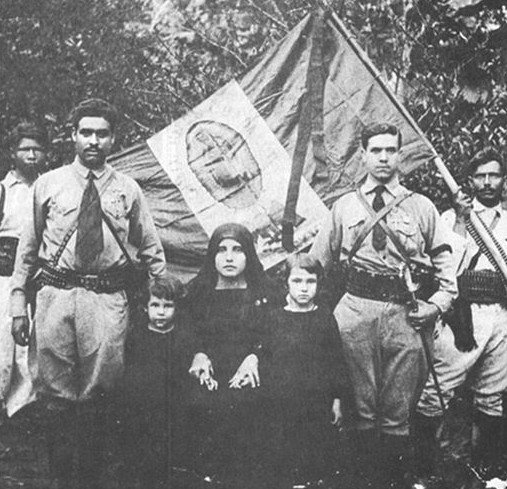
Articles

Mexican States
Southwest United States
Heritage and Governance
Nuevo Santander: The Settlement of the Rio Grande
This presentation will discuss the settlement and evolution of the Nuevo Santander Colony along the Rio Grande. José de Escandón’s Villas del Norte– established in the mid- Eighteenth Century – appeared like a string of pearls along the Lower Rio Grande River, where Spain was reinforcing the distant frontier of its American empire.
Indigenous Chihuahua: Four Centuries of Conflict
The Sierra Madre Occidental Mountains run from south of the Arizona-Sonora border southeast through eastern Sonora, western Chihuahua, Sinaloa, Durango, Zacatecas, Jalisco and farther south. The Sierra Madre Oriental Mountains run parallel to the Sierra Madre Occidental range on the eastern side of the country.
The Germans In Mexico (1821-1910)
The German Merchant Colony in Mexico
Mexico became independent from Spain in 1821 after an eleven-year armed struggle against that European nation which had colonized it since 1519. The subsequent period from 1821 to 1876 was a period of great instability and economic stagnation for Mexico. During this period Mexico was ravaged by civil wars between rival generals, as well as foreign wars against other countries (Spain, United States, France).
Indigenous Nueva Galicia: The Native Peoples of Jalisco and Zacatecas
Established in 1548, the Spanish province of Nueva Galicia embraced 180,000 kilometers and included most of present-day Jalisco, Nayarit, Aguascalientes and Zacatecas. Across this broad range of territory a wide array of indigenous groups lived during the Sixteenth Century. The old Aztec empire had been replaced with Nueva España.
Indigenous Oaxaca and the Census
Oaxaca is characterized by extreme geographic fragmentation with extensive mountain systems, wide tropical coastal plains and fertile valleys. The entire state is very mountainous, being crossed by three cordilleras:
1. The Sierra Madre Oriental in western Oaxaca.
2. The Sierra Madre del Sur covers 70% of the state territory.
3. The Sierra Atravesada in the region of the Isthmus of Tehuantepec.
The 2020 Census: An Ethnic Overview of Mexico
Mexico’s 2020 Population and Housing Census was conducted in March 2020. More than 147,000 interviewers traveled the nearly two million square kilometers of the national territory, visiting all Mexican households to obtain information about the demographic, socioeconomic and cultural characteristics of the people of each state.
Searching the Early California Population Project (ECPP) Database
This presentation will discuss the ECPP database, with suggestions on how to use it. To the beginner, this database -- with dozens of search fields -- seems challenging and confusing, but John Schmal will describe how to use it effectively, and after that will do selected searches to show examples of baptism and marriage documents of California Mission Indians and of Mexican soldiers and their families.
Tracing Your Indigenous Roots in Northeast Mexico and Texas
Learn to trace your indigenous roots in northeastern Mexico and south Texas. Historian, genealogist, and author John P. Schmal will discuss the various tribal groups inhabiting this region; research techniques for finding your ancestors in this area; and helpful websites.
The Indigenous People of Northeastern Mexico: Past and Present
Today, in the northeast corner of Mexico, there are two Mexican states, Tamaulipas and Nuevo León. When the Spaniards arrived in this area in 16th Century, they were confronted by a large number of hostile indigenous tribes. Over time, the Coahuiltecans – the dominant linguistic group in the region – were weakened by epidemics, warfare, the Spanish encomienda, forced slavery, dispersion and general demoralization. With the Spaniards coming from the south and Apaches and Comanches attacking from the north, the Coahuiltecans declined significantly within the period of a century, many of them seeking refuge in the Spanish missions.
Divided Loyalties: The Indigenous Peoples Who Occupy the US-Mexico Borderlands
This presentation discusses the native groups that occupied the regions adjacent to and on both sides of the U.S.-Mexico border over the last three centuries. While some of these tribes are well-known to us today (i.e., the Yaquis, Tohono O'odham, Kumeyaay, etc.), tribal groups that have nearly disappeared as distinguishable cultural entities (i.e., Carrizos, Mansos, Jocome, Coahuiltecans, etc.) will also be discussed. In addition to the history of those tribes, we will explore the current status of some of the tribal communities that still exist today.
The Cristero Rebellion: Its Origins and Aftermath
The Cristero Rebellion – also known as La Cristiada – was a popular uprising in 1926-29 of Catholic peasants in the central-western Mexican states against the secularist, anti-Catholic and anti-clerical policies of the Mexican government under President Plutarco Elías Calles. The rebellion took place in response to the imposition of the Calles Law which strictly enforced the secularist and anticlerical articles of the 1917 Constitution of Mexico.
Hispanics and Indigenous People in the San Fernando Valley of California
This presentation explores the original settlement of the Los Angeles Basin and the San Fernando Valley, including the Expedition of 1781 and the establishment of the San Gabriel Mission (1771) and the San Fernando Mission (1797). The lecture also includes a discussion of the original indigenous inhabitants who lived near the Spanish missions. The presentation will discuss how the San Fernando evolved through occupation by three powers (Spain, Mexico and the U.S.).
Southern California’s Native American Tribes
This presentation explores the Native American people that inhabited Southern California in the 18th Century. The region from San Diego to Santa Barbara will be discussed. The current status of these tribes in the present day will also be discussed.
Indigenous Hidalgo and the Census
From 1895 to 2015, the Mexican census has painted a picture of Mexico’s people, providing details about languages spoken (Spanish, foreign and indigenous), religion, education, literacy, employment and migration. From the beginning, the Mexican census provided details about indigenous languages spoken by its citizens. However, in the first half century, it is possible that there were undercounts of indigenous language speakers because some may have failed to declare their language status for fear of affecting their position within the community. In addition, poor communications channels with rural, isolated indigenous communities may also have caused an undercount of the indigenous people.
Indigenous Chiapas and the Census
From 1895 to 2015, the Mexican census has painted a picture of Mexico’s people, providing details about languages spoken (Spanish, foreign and indigenous), religion, education, literacy, employment and migration. From the beginning, the Mexican census provided details about indigenous languages spoken by its citizens. However, in the first half century, it is possible that there were undercounts of indigenous language speakers because some may have failed to declare their language status for fear of affecting their position within the community. In addition, poor communications channels with rural, isolated indigenous communities may also have caused an undercount of the indigenous people.
Exploring Jalisco’s Indigenous People: Past and Present
Today, Jalisco is the seventh largest state of Mexico with a diverse terrain that gave rise to an incredible diversity of tribal groups. Professor Eric Van Young has noted that the area of central Jalisco “supported relatively dense populations” and a “considerable ethnolinguistic variety prevailed within a fairly small geographic area.” But the expedition of Nuño de Guzmán (1529-1531) changed everything and many tribal groups were decimated during the next two decades, especially after the Mixtón Revolt (1540-1541).
Indigenous Tamaulipas: The Seno Mexicano and Nuevo Santander
The state of Tamaulipas is located in the northeastern portion of the Mexican Republic. It shares common borders with the Mexican States of Nuevo León (to the west), San Luis Potosí (to the southwest) and Veracruz (to the south). It also shares its northern boundary with Texas. On its east, Tamaulipas also has a 458-kilometer long coastline along the Gulf of Mexico.
Indigenous Tamaulipas: Ancestors of the Tejanos
The State of Tamaulipas once boasted a very large number of indigenous groups. Most of the region was largely unexplored and unexploited until the middle of the 18th Century when Jose de Escandón established the colony of Nuevo Santander. Although Gabriel Saldivar’s “Los Indios de Tamaulipas” (1943) references four primary indigenous groups within the borders of the present-day state, the Coahuiltecans made up the bulk of the northern bands along the Rio Grande River. However, with Spaniards coming from the south and Apaches and Comanches attacking from the north, the Coahuiltecans declined significantly within the period of a century, many of them seeking refuge in the Spanish missions
Monolingualism in Mexico (2010)
Mexico’s Census agency is the Instituto Nacional de Estadística y Geografía (INEGI) — known to Americans as the National Institute of Statistics and Geography. Every ten years, INEGI publishes a census showing various population statistics for all residents living in Mexico.
Los Extranjeros in Mexico (1895-2010)
Immigration to Mexico
From the early Sixteenth Century to the end of the Nineteenth Century, Mexico saw a continuous surge of immigrants from Spain. But several other countries — most notably Portugal, Italy, Germany, France, the Philippines and China — also contributed a steady stream of immigrants to various parts of Mexico through the centuries. Immigration from North America and other parts of Latin America and the Caribbean has also been healthy over the long haul.

Article Categories
- Aguascalientes 14
- Arizona 4
- Baja California 5
- Baja California Sur 2
- California 20
- Campeche 4
- Census 36
- Chiapas 3
- Chihuahua 11
- Coahuila 7
- Colima 1
- Conquistador Chronicles 2
- Durango 2
- Ethnic Identity 41
- Genealogy 35
- Guanajuato 8
- Guerrero 8
- Hidalgo 2
- Indigenous Insights 98
- Jalisco 25
- Mexico City 11
- Michoacan 7
- Morelos 4
- Nayarit 3
- New Mexico 4
- Nuevo Leon 7
- Oaxaca 6
- Politics 10
- Puebla 5
- Queretaro 1
- Quintana Roo 4
- San Luis Potosi 11
- Sinaloa 6
- Sonora 16
- Southwest US 26
- State of Mexico 5
- Tabasco 3
- Tamaulipas 11
- Texas 7
- Tlaxcala 7
- Veracruz 6
- Yucatan 6
- Zacatecas 13





















